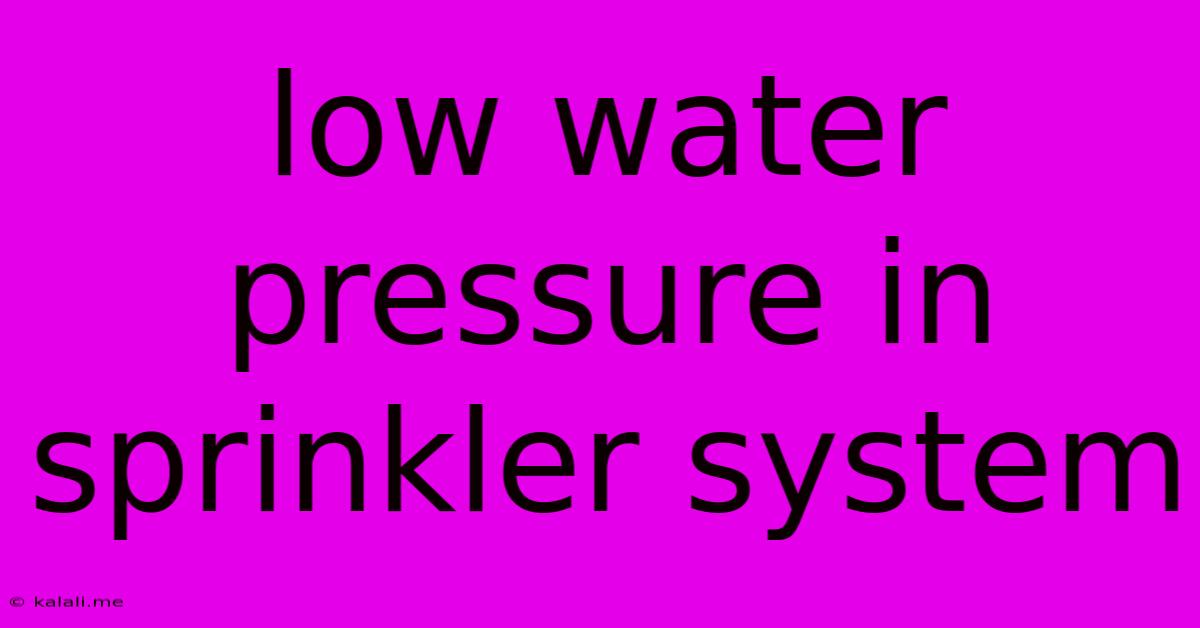Low Water Pressure In Sprinkler System
Kalali
Jun 09, 2025 · 4 min read

Table of Contents
Low Water Pressure in Sprinkler System: Troubleshooting and Solutions
Low water pressure in your sprinkler system can be frustrating, leading to uneven watering and potentially damaging your lawn. This comprehensive guide will help you diagnose the problem and find effective solutions, ensuring your landscape receives the proper hydration. We'll cover common causes, troubleshooting steps, and preventative maintenance.
Understanding the Problem: Why is My Sprinkler Pressure Low?
Several factors can contribute to low water pressure in your sprinkler system. Identifying the root cause is crucial for implementing the correct fix. Issues can range from simple clogs to more complex plumbing problems. A consistent lack of water pressure can affect the overall health of your garden, leading to brown patches and stressed plants.
Common Causes of Low Sprinkler Water Pressure
- Clogged Sprinkler Heads: This is often the simplest and most common culprit. Mineral deposits, dirt, and debris can restrict water flow, significantly reducing pressure.
- Clogged Pipes: Similar to clogged sprinkler heads, sediment and debris can accumulate within the pipes over time, restricting water flow throughout the entire system. This is especially common in older systems.
- Water Main Issues: Low water pressure from the municipal water supply can affect your sprinkler system. Check with your neighbors to see if they are experiencing similar problems. Contact your local water authority if this is suspected.
- Leaking Pipes: Leaks anywhere in your underground sprinkler system will reduce the pressure at the sprinkler heads. These leaks can be difficult to find but significantly impact water pressure.
- Incorrect Valve Settings: Make sure all valves are fully open. Partially closed valves drastically reduce water flow to specific zones.
- Backflow Preventer Issues: A malfunctioning backflow preventer can restrict water flow. While essential for preventing water contamination, a faulty unit needs professional attention.
- Pump Problems (for well-fed systems): If your system uses a well pump, issues with the pump itself, such as a failing motor or worn impeller, can severely reduce water pressure.
Troubleshooting Low Sprinkler Pressure: A Step-by-Step Guide
- Check the Sprinkler Heads: Begin by inspecting each sprinkler head individually. Remove and clean any visible debris or mineral deposits. A simple soak in vinegar can often remove stubborn clogs.
- Inspect the Valves: Ensure all valves controlling your sprinkler zones are fully open. Listen for any unusual noises indicating a problem with the valve.
- Examine the Water Meter: Check your water meter to see if it's registering water flow when the system is running. A lack of movement indicates a blockage closer to the source.
- Look for Leaks: Carefully inspect all visible sections of your sprinkler piping for leaks. These can often be detected by a damp or wet patch of ground.
- Test the Water Pressure: Use a water pressure gauge to measure the pressure at various points in the system. This will help pinpoint the location of any pressure loss.
- Check the Backflow Preventer: Inspect the backflow preventer for any signs of malfunction or blockage. This often requires professional attention.
Solutions for Low Sprinkler Water Pressure
- Replace Clogged Sprinkler Heads: If cleaning doesn't resolve the issue, replace the affected sprinkler heads.
- Flush the System: A thorough flushing of the entire sprinkler system can remove sediment and debris from the pipes. This might require professional help depending on the system's complexity.
- Repair Leaking Pipes: Repair or replace any leaking pipes identified during your inspection.
- Replace a Faulty Backflow Preventer: Contact a qualified plumber to replace a malfunctioning backflow preventer.
- Professional Help: For complex problems, or if you're uncomfortable performing repairs yourself, contact a qualified irrigation specialist. They possess the expertise and tools to diagnose and resolve even the most challenging water pressure issues.
Preventative Maintenance: Keeping Your Sprinkler System Healthy
Regular maintenance is key to preventing low water pressure and ensuring your sprinkler system's longevity. This includes:
- Annual System Flush: Flush the system at the beginning and end of the irrigation season to remove debris.
- Regular Sprinkler Head Inspection: Inspect sprinkler heads for clogs and damage throughout the season.
- Check Valves Regularly: Ensure all valves operate correctly and are not partially closed.
By following these steps and adopting a preventative maintenance schedule, you can effectively address low water pressure in your sprinkler system, ensuring a healthy and vibrant landscape. Remember to prioritize safety and call a professional if you're unsure about any repair procedures.
Latest Posts
Latest Posts
-
How To Pass Level 7 In Bloxorz
Jul 01, 2025
-
How Much Years Is 1 Billion Minutes
Jul 01, 2025
-
I Reject Your Reality And I Substitute My Own
Jul 01, 2025
-
5 X 5 X 5 X 5
Jul 01, 2025
-
How Many Cups In A 5th Of Vodka
Jul 01, 2025
Related Post
Thank you for visiting our website which covers about Low Water Pressure In Sprinkler System . We hope the information provided has been useful to you. Feel free to contact us if you have any questions or need further assistance. See you next time and don't miss to bookmark.